The following is Part 3 of Matt Walsh’s edited and abridged Personal Journal for August 2-7, 2007, recounting his surveying exploits with James Taylor and Dima Chvagian in the North Central Kuril Islands. All photos, unless otherwise note, are courtesy of Matt Walsh.
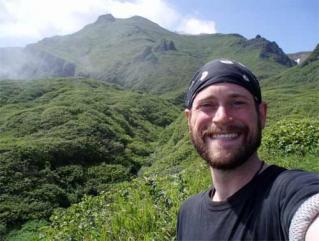 Matt Walsh
Matt Walsh
August 6, 2007
This morning the storm was still with us when I woke up around 7am. The rain had become little more than a drizzle, but the wind and waves were trying their best to make up for it. After breakfast there was an impromptu meeting in the galley to formulate some sort of plan and try to decide what to do with the day. The captain suggested that we stay aboard ship, discouraging us from heading out to survey because of the nasty weather, but he conceded that it was at least physically possible to land the zodiac in a small leeward grotto along the shoreline, only partially visible from the ship and guarded on two sides by towering stone crags. The conversation strangely deteriorated into a quiet sort of one-upmanship and James and I were not about to back down in our Russian company. If anyone was going to go to shore, we made it clear we would be ready to go. It was decided that we would wait an hour and see how the weather looked. Within an hour the storm cleared and we were on deck ready to depart. Only a few minutes later, we were in the zodiac, speeding through the waves and salty spray toward a tiny gap in the crashing Pacific surf.
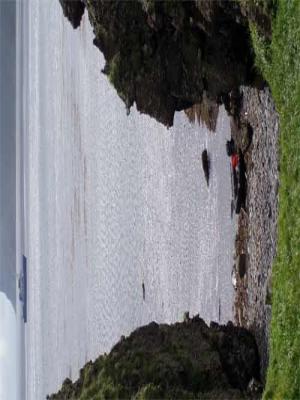 The grotto where we landed on the Pacific coast of Shiashkotan. Dima Chvagian is at the bottom right. Morning, Aug. 6th. (Photo courtesy of Matt Walsh)
The grotto where we landed on the Pacific coast of Shiashkotan. Dima Chvagian is at the bottom right. Morning, Aug. 6th. (Photo courtesy of Matt Walsh)
*The grotto where we landed on the Pacific coast of Shiashkotan. Dima Chvagian is at the bottom right. Morning, Aug. 6th. *
* *
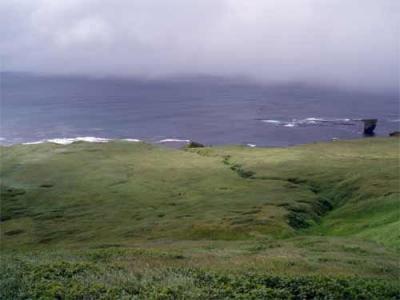 View of the Pacific Ocean and one of the expansive terraces on Shiashkotan. It looks easy going from here, but the grass is about a meter high and covers rough ground. If you look carefully, the tiny dot in the middle left is James Taylor from about half a kilometer away. Late Morning, Aug. 6th. (Photo courtesy of Matt Walsh)
View of the Pacific Ocean and one of the expansive terraces on Shiashkotan. It looks easy going from here, but the grass is about a meter high and covers rough ground. If you look carefully, the tiny dot in the middle left is James Taylor from about half a kilometer away. Late Morning, Aug. 6th. (Photo courtesy of Matt Walsh)
View of the Pacific Ocean and one of the expansive terraces on Shiashkotan. It looks easy going from here, but the grass is about a meter high and covers rough ground. If you look carefully, the tiny dot in the middle left is James Taylor from about half a kilometer away. Late Morning, Aug. 6th.
When we got to shore the sun was barely glowing behind the constant grey sky. We hiked out of the grotto up on to the expanding terrace. A light wind slashed down from the shrouded mountain tops to the west and tumbled into the bracing Pacific wind that swept in from the east. We hiked through knee-high grass that rustled in swirling waves around us, and made our way toward the mountains to get a better view of the terrace.
Once we got to the first ridgeline no archaeological features were visible from our perch just below the dwarf birch and spruce. We decided to make our way back down and walk the length of the terrace to the north. By noon we’d walked a few kilometers and found nothing. The weather was actually quite nice, but ominous clouds were moving in quickly. We decided to head back to the grotto and await pickup. Maybe a kilometer from our destination I stumbled upon what looked like it might be a house pit, badly eroded and overlooking the Pacific. We probed it for charcoal and found some with the first try.
The entire terrace was covered in grass-covered hummocks, making survey difficult. But as we surveyed the surrounding area we quickly established a number of obvious pit features and a few that may or may not have been manmade. James made a profile in the eroding cliff side that faced out to the ocean, while I made a rough map of the immediate area. Dima took pictures and then helped me take charcoal samples from a few probes that I sank in the larger, more obvious pits.
Miraculously, the weather remained clear for us as we finished up collecting samples and restarted our march back toward the secluded grotto that would lead us back to the ship. The site, Rebristyy 1, is our fourth new site in five days of survey. Our luck has been unprecedented. Midway from our newly-discovered site we ran into the Japanese Volcanologists again as they examined a creek-side erosion profile; the very profile in fact, that James and I had given a cursory glance at on our way up to the hillside. We sat and took a break for a few minutes and waited until they were done drawing the profile and taking tephra samples from the exposed stratigraphy. Then we all meandered in the wind back to the pickup point.
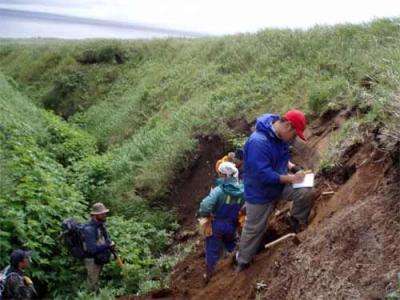 Documenting the stratigraphy of an exposed erosional face. From left to right: Dima Chvagian, James Taylor, Yoshihiro Ishizuka, Mitsuhiro Nakagawa, and Ahira Baba. Afternoon, Aug. 6th. (Photo courtesy of Matt Walsh)
Documenting the stratigraphy of an exposed erosional face. From left to right: Dima Chvagian, James Taylor, Yoshihiro Ishizuka, Mitsuhiro Nakagawa, and Ahira Baba. Afternoon, Aug. 6th. (Photo courtesy of Matt Walsh)
*Documenting the stratigraphy of an exposed erosional face. From left to right: Dima Chvagian, James Taylor, Yoshihiro Ishizuka, Mitsuhiro Nakagawa, and Ahira Baba. Afternoon, Aug. 6th. *
When we arrived at the rendezvous, Igor, the boat driver, was nowhere to be found, so we all settled into a crack in the rocks and ate lunch. We waited a little more than an hour and the sky grew steadily greyer and the wind became distinctly cold. Iskatel blew her horn a few times and the radio conversation that followed sounded as if the captain was none too happy that we were taking so long. Eventually, Igor came barreling into the grotto and we set about preparing the zodiac for the crossing back to the ship.
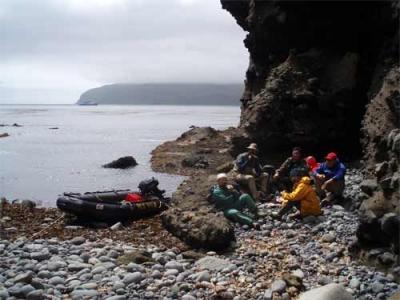 A view of Iskatel coming into view between the barrier rocks of the sheltered grotto as we ate a late lunch. From left: Yoshihiro Ishizuka, James Taylor, Dima Chvagian, Mitsuhiro Nakagawa, and Ahira Baba. Afternoon, Aug. 6th. (Photo courtesy of Matt Walsh)
A view of Iskatel coming into view between the barrier rocks of the sheltered grotto as we ate a late lunch. From left: Yoshihiro Ishizuka, James Taylor, Dima Chvagian, Mitsuhiro Nakagawa, and Ahira Baba. Afternoon, Aug. 6th. (Photo courtesy of Matt Walsh)
*A view of Iskatel coming into view between the barrier rocks of the sheltered grotto as we ate a late lunch. From left: Yoshihiro Ishizuka, James Taylor, Dima Chvagian, Mitsuhiro Nakagawa, and Ahira Baba. Afternoon, Aug. 6th. *
The grotto was secluded enough to block the larger waves from pounding into its tiny kelp-clogged harbor, but once beyond the rocks, the wind tossed cold, bitter waves into our faces as the little zodiac hummed its way out toward the ship. By the time I climbed up the rope ladder that leads to the safety of the back deck, I was drenched and grinning from ear to ear. James and I shared a laugh as he announced that it had been a good day; we’d found a small, but previously unknown archaeological site and had managed to make it safely back to the ship before the next storm endeavored to encircle the area.
This afternoon, after returning to the ship at around 3pm we had a meeting with the captain and planned out the next few days. The plan is to visit a site on the northern Okhotsk side of Shiashkotan tomorrow and pick up three of the IMGG geologists. On the day after we will head to Drobnyye to pick up the American archaeologists and Shubin’s team. Apparently, Ben called the captain yesterday and told him they were ready to be picked up, which is odd, since Ben always wants more time, not less. James intends to contact Ben tonight by phone and find out what’s going on and tell him about our discovery on Chirinkotan. We’re hoping that we can convince him to let us revisit the Chirinkotan site with the rest of the group before heading to Matua to pick up the geology teams two days from now.
As night fell around the ship we tried in vain to capture images of the crescent moon that gleamed golden across the water through a space in the mist.
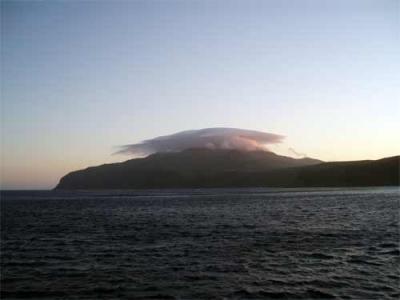 Clouds blanket Obval’nyy volcano from the southern Pacific coast of Shiashkotan at dusk. Evening, Aug. 6th. (Photo courtesy of Matt Walsh)
Clouds blanket Obval’nyy volcano from the southern Pacific coast of Shiashkotan at dusk. Evening, Aug. 6th. (Photo courtesy of Matt Walsh)
Clouds blanket Obval’nyy volcano from the southern Pacific coast of Shiashkotan at dusk. Evening, Aug. 6th.
August 7, 2007
This morning the waves continued to pick up intensity and the ship steamed north and west around Shiashkotan and then south along the Okhotsk coast. After breakfast the sky cleared and we had a brilliant view of the surrounding islands.
The wind has been steadily growing stronger and it was not possible to pick up the IMGG group on northern Shiashkotan, so we continued south past Drobnyye and could see the archaeology camp on shore, smoke gently rising from their camp fire. We thought we might be stopping to begin picking them up but the ship continued on with the wind and we finally stopped just off the southwest edge of the island.
Dima wanted to go to shore to survey and we had a difficult time communicating to him that the area had already been surveyed during last year’s expedition. Finally, during lunch, Sasha Belusov translated for us and Dima, finally understanding what must have been rather confusing, contented himself that we would probably not be going to shore.
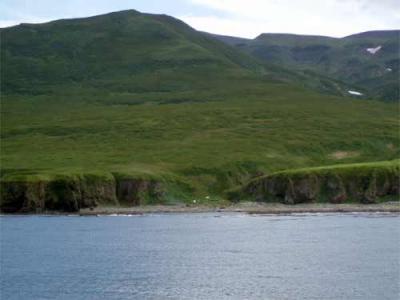 The camp at Drobnyye. Excavations last year on the terrace to the right yielded both Okhotsk and Epi-Jomon ceramics as well as a number of stone flakes and tools. The terrace to the right may have been a relatively large Okhotsk settlement. Late Morning, Aug. 7th. (Photo courtesy of Matt Walsh)
The camp at Drobnyye. Excavations last year on the terrace to the right yielded both Okhotsk and Epi-Jomon ceramics as well as a number of stone flakes and tools. The terrace to the right may have been a relatively large Okhotsk settlement. Late Morning, Aug. 7th. (Photo courtesy of Matt Walsh)
*The camp at Drobnyye. Excavations last year on the terrace to the right yielded both Okhotsk and Epi-Jomon ceramics as well as a number of stone flakes and tools. The terrace to the right may have been a relatively large Okhotsk settlement. Late Morning, Aug. 7th. *
The site, named Grotovyy, has archaeological sites, we explained, but we already had dates and survey information and any survey we performed there would be redundant and unnecessary. He nodded over his soup and said nothing, feigning his best dejected looked. Yesterday, after our discovery of the Rebristyy site, Dima, in good spirits, had patted James and I both on the back and announced, "We… very good team.”
This afternoon we picked up the archaeology team at Drobnyye. The wind and swells made the trips to and from shore difficult, but luckily James and I stayed aboard the ship and just had to help unload the zodiacs as they returned through the two meter high swells. Unloading was tough with the waves constantly raising the tiny boats and then promptly dropping them again, making the action of passing things up to the ship not only dangerous but frustrating. A fog moved in half way through the process and obscured everything in a blanket of soft white against the blue-black sea. The ship had to blow its horn so the zodiacs could locate her in the mist. After a few hours though, everyone was back on board in the relative safety of the Iskatel’s rails.
With the return of the Drobnyye teams the ship once again feels full and as I write this we are steaming through the endless waves toward Matua. Above deck, in the half light of dusk it is impossible to see more than a few feet out from the ship and it gives the spooky impression that we are sailing blindly into the unknown. Thank god for modern navigation equipment.
Tomorrow we will pick up the Matua teams and some of us will possibly spend part of the day on shore at Ainu Bay. Jody radioed to Ben that the November 2006 tsunami completely devastated the shoreline there and exposed a number of archaeological sites in its erosional wake. It will be good to see everyone again, as it has been to see our recently returned compatriots today. With Misty back on board I hope to be able to e-mail home and send some word to Marnie and my folks. I’m still fighting the urge to start counting down the hours, but with thirteen days left it may be a bit of a stretch. In my heart I’m already home.
We have, maybe, four more days of field work before making the return voyage to Korsakov and then to Yuzhno-Sakhalinsk. Once there, it will be roughly 5-7 days counting samples and loading crates for the return to Seattle. I keep reminding myself of a quiet promise that I plan on keeping - next year I’m staying home and enjoying a leisurely summer. It is 9 o’clock pm on the 7th, only 291 hours left to go…
Matt Walsh

